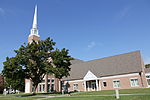WBEL (AM)
1948 establishments in Illinois1990s radio stations in the United StatesRadio stations established in 1948Radio stations in Illinois
WBEL (1380 AM) is a 90s hits radio station in South Beloit, Illinois with studios in Janesville, Wisconsin. Established in 1948, the station is owned by Big Radio. Its programming is simulcast on translator stations W222AU (92.3 FM) in Beloit, Wisconsin and W255CZ (98.9 FM) in Janesville.
Excerpt from the Wikipedia article WBEL (AM) (License: CC BY-SA 3.0, Authors).WBEL (AM)
Bayfield Road, Roscoe Township
Geographical coordinates (GPS) Address Nearby Places Show on map
Geographical coordinates (GPS)
| Latitude | Longitude |
|---|---|
| N 42.459444444444 ° | E -89.028611111111 ° |
Address
WBEL-AM (South Beloit)
Bayfield Road
61080 Roscoe Township
Illinois, United States
Open on Google Maps








